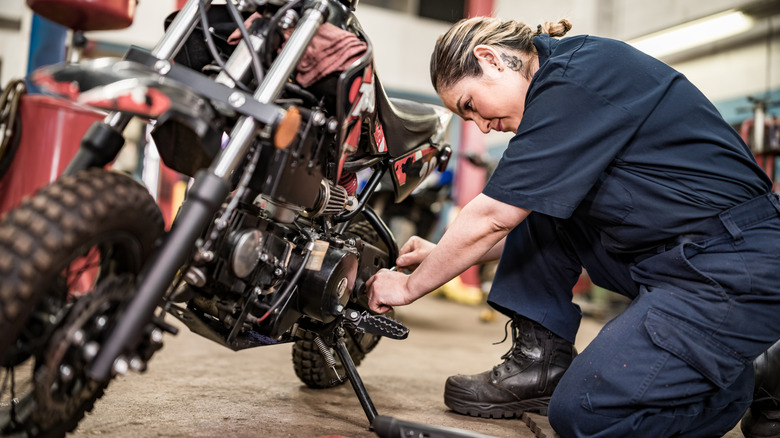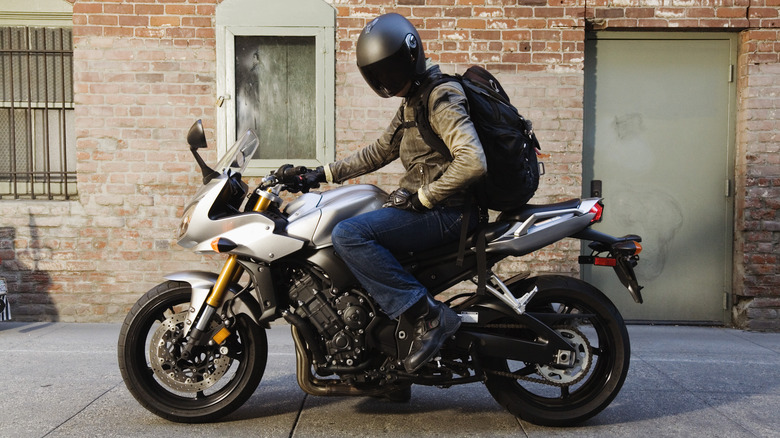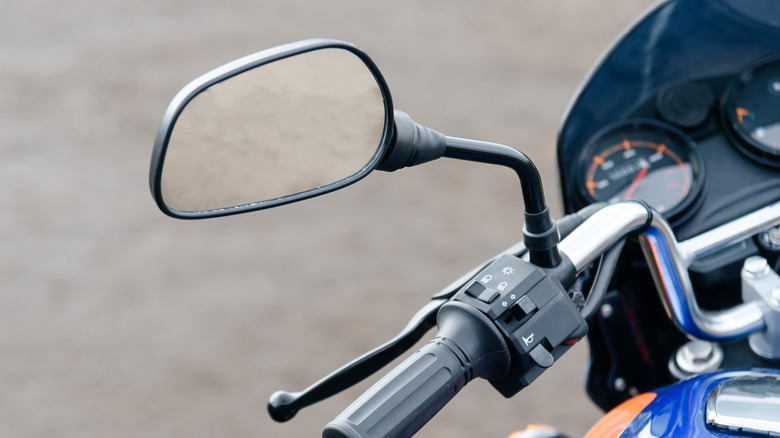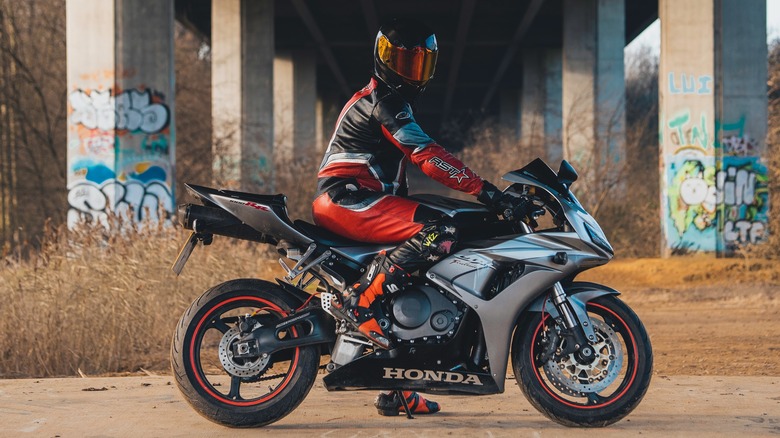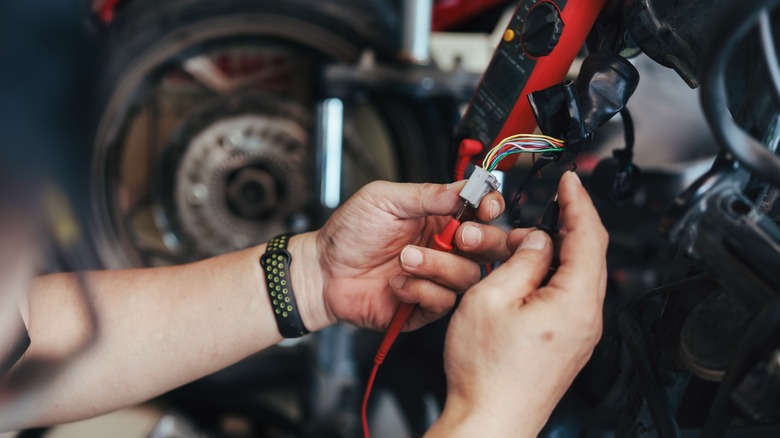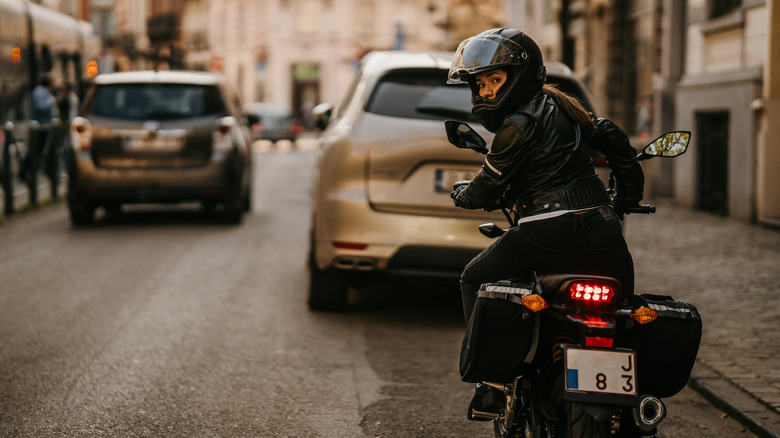5 Of The Most Difficult Motorcycle Accessories To Ride With
There are lots of great accessories available for motorcycles, and we've certainly got some favorites here at SlashGear. Many of the best accessories, like emergency communication systems, tool kits, and tire repair kits, make your riding life easier or safe. Other accessories, like smartphone mounts or helmet communication systems for group rides, can add convenience to a motorcycle journey. Not all accessories, however, make life on two wheels easier.
Some accessories, many of which may seem helpful at first, can make riding more difficult. In the years I've spent riding, I've made plenty of the classic blunders when it comes to accessories and gear, modifying (and then un-modifying) several motorcycles along the way. Here are the things I've used on my bikes while riding that made things worse, and the lessons I've learned along the way. Not every ride or rider is the same, so some of these won't apply to you and your bike. For me, though, these are the most frustrating, difficult-to-ride-with accessories.
Backpacks
A backpack seems like a pretty no-nonsense solution if you need to carry stuff. Whether you've got extra clothes to change into after your ride, some supplies for an overnight stay at a campsite, or a repair kit to make sure your bike stays roadworthy, a backpack seems like the right solution. There are even backpacks made specifically for riding different kinds of motorcycles. But for me, backpacks are a last resort.
To keep a backpack on while riding at highway speed, it needs to be on pretty tight, which can restrict upper body movement. On sport bikes, your helmet will likely tap larger backpacks when you need to lean forward and tilt your head up, which may also restrict your ability to move your head. When I'm riding, moving my upper body is important. What's more, a backpack keeping air from flowing through my jacket makes me even hotter on summer rides.
Instead of using a backpack, you can try hard-mounted motorcycle storage. A top case will help keep your bike slender while it's on the go and also give you storage. Meanwhile, side cases (also known as panniers) will do the same job, though they may add some width. Other helpful, non-restrictive solutions like soft-top cases are worth checking out, too. They can be strapped down to a motorcycle's rear seat for some extra storage, though that will eliminate your ability to carry a passenger.
Bad mirrors
I understand the desire to modify your motorcycle to look its best. In fact, I love the look of the aftermarket mirrors on my cafe-style bike. They make the front end of the bike look sleek and give me a less impeded view of the road ahead. However, aftermarket mirrors, like the ones on my bike, make seeing behind me a tough task. Instead of being mounted high above the handlebars, lots of cafe bikes and plenty of cruisers have dropped-down mirrors that sit below the handlebars.
It may be aesthetically pleasing, but it interrupts the sole purpose of having mirrors: to see what's behind you. If you're wearing a full-face helmet, generally the large chin bar restricts your view downward, which means you can't see the mirrors at a moment's glance. In a scenario where someone hits the brakes hard in front of you, spot-checking your mirror and swerving could be a quick way out of trouble.
Some riders, especially on sportbikes, opt for slim mirrors up front that can be easily folded inward, but I've found those to be just about as difficult to use. That's because they offer an extremely limited field of view. Lots of aftermarket mirrors look good, but they're difficult to ride with. It's a trade-off I'm willing to make on a bike I don't ride very much, but if I were commuting on a motorcycle or riding it regularly, I'd want to stick with stock-height mirrors instead.
A tinted visor (at night)
This one is less of an accessory for your bike and more an accessory for your gear. Wearing a tinted visor on your motorcycle helmet can be great for bright sunny days. You don't have to fiddle with wearing sunglasses under your helmet, and you can keep a bit of the sun off your face. For riders that wear prescription glasses, a tinted visor means you don't have to carry around a pair of prescription sunglasses. But if you get caught out after dark and you forgot to bring your standard, clear visor, it can be a struggle.
For virtually every helmet I've ever owned, I've used a tinted visor. It helps my eyes from becoming fatigued on long rides. Riding with a tinted visor at night, however, makes it extremely difficult to see. I've had to make the decision more than once to flip up my visor and deal with the dirty, turbulent air, just to properly see what's ahead of me.
Bringing along an extra visor for when it gets dark out is relatively easy if you've got some extra storage (like that top case mentioned earlier), but a visor can also be tucked in-between your jacket and under-layer in a pinch. A small aside: Having the right visor for the right weather is important. Pinlock systems also help to keep helmets from fogging up, so be sure to look into one if you have cold or damp weather in your area as well.
Bad electronic add-ons
In my time buying and selling used motorcycles, I've inherited more than a few electrical issues. Riders adding extra equipment to motorcycles like aftermarket cruise control, underbody glow, or even upgraded headlights can often lead to dead batteries, errant engine codes, or cascading failures throughout the motorcycle. Even something as small as a poorly installed USB charging cable can drain your battery in a hurry. A drained battery has left me stranded on more than one occasion, and even though I was able to bump-start my motorcycle a few times to get things going again, I wasn't happy about the issue.
When you're installing an aftermarket accessory, make sure it doesn't contribute to parasitic drain when not in use, especially while your motorcycle is parked. If it does, find a trickle-charger to keep things topped up or install a battery disconnect. If you're adding features like extra lights to your motorcycle, figure out the capacity for your alternator and make sure your accessories don't exceed that output.
Extra-tall ape hangers
When form becomes more important than function, you get mods like ape hanger handlebars. Like the name suggests, ape hangers are handlebars that are much higher than what's provided from the manufacturer. Hanging on to such big-and-tall bars makes the riding experience feel a bit like a primate hanging from branches in the forest. I've only had the opportunity to ride and sit on a few motorcycles with these ultra-tall handlebars, but I knew immediately that they weren't for me.
Some manufacturers claim that ape hangers improve responsiveness and handling on various cruiser motorcycles. That's plausible if you go with something moderate. What I'm talking about, however, are the extra-tall bars. They make the bike tough to control, especially at slow speeds. Over long distances, the blood will flow away from your hands, potentially causing your arms to go numb. If you're riding short distances and are concerned more with the aesthetics of your bike, ape hangers might fit your needs. For most riders, though, they'll cause more trouble than they're worth.
Methodology
The accessories listed here are all based on my personal experience, including several years of riding a wide variety of bikes. I've spent time on a number of different motorcycles, with both good accessories and bad, and these are my takeaways as to which accessories made life worse. Not every backpack, electrical add-on, or tinted visor is going to ruin your riding experience, but in the listed scenarios it's certainly a possibility that riding will be tougher. For instance: A backpack on an adventure ride might be a necessity, but for every day city riding, I'd much prefer a tail or tank bag.
